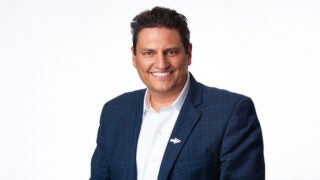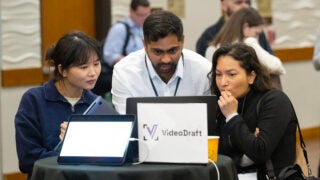Grad students learn the art of fellowship funding at USC
Application workshops pay off with a record number of National Science Foundation Fellowships
https://youtu.be/ZrRr1YCibO8
Preparing for grad school these days means more than being ready for late nights in the lab. It can also mean looking for fellowship opportunities that could jumpstart a young scholar’s career.
At USC, students are taught how to write fellowship applications that shine — and the efforts are paying off. This year, 37 Trojans were awarded or received an honorable mention for the coveted National Science Foundation Graduate Research Fellowship, which provides a $34,000-per-year stipend for three years and opens doors to international research opportunities. In 2010, USC had just eight recipients.
“It’s basically the Harry Potter scar on your forehead indicating you’re an amazing scholar,” said Meredith Drake Reitan, associate dean for graduate fellowships at the USC Graduate School. There are about 2,000 NSF Fellowships awarded each year, and competition is fierce, Drake Reitan said. The success is rate is about 15 percent.
“The fellowship program is about research potential,” she said. “Faculty members might say, ‘They’re not ready to apply to for the NSF Fellowship because their research hasn’t quite jelled.’ But that’s actually right where the NSF wants them — it’s designed to be an early career accelerator.”
Besides encouraging faculty to talk to more students about fellowship opportunities, the Graduate School is actively preparing them for the application process. Last year, the school hosted its first boot camp for the process. Forty-five students heard from current or former fellows as well as those who had served on review committees. In addition to the NSF program, they learned about the Ford Foundation Pre-Doctoral Fellowship and the Soros Fellowship.
Success after the first attempt
Panthea Heydari, a student in USC’s Graduate Neuroscience Program, is a current NSF Fellow. Unlike most applicants, she received the award on her first try. She had heard how competitive the program was and figured she didn’t have much chance, but could at least learn from the experience and prepare for a stronger application in the future.
But the review committee was impressed. Heydari studies stroke rehabilitation in patients selected from lower-income areas surrounding USC, Keck Hospital and Ranchos Los Amigos Hospital in Downey. The fact that her research could have a direct impact on these communities was a key part of her application.
What Heydari learned was how to convey her research quickly and with passion. A former NSF Fellowship reviewer spoke to participants about having just a few minutes to look over each application, then making a case for the most deserving applicants.
There really needs to be a way to catch the reader’s attention and fight for your proposal.
Panthea Heydari
“There really needs to be a way to catch the reader’s attention and fight for your proposal,” Heydari said. “If it comes down to a tie, they fight for you. I kept coming back to that idea when I was writing.”
From Texas to USC Annenberg
Ignacio Cruz is another one of this year’s NSF Fellows — the first from the USC Annenberg School for Communication and Journalism. Cruz is a first-generation student who received his undergraduate degree last year from the University of Texas, Austin. He decided to jump straight into a PhD program at USC Annenberg, where he’s studying how communication technologies affects the workplace: How do they influence office social networks, harm or help productivity or lead to communication overload?
Cruz represents a small but growing group of NSF Fellows, nationally and at USC: social scientists.
“Sometimes people think these awards only go to the hard sciences,” Cruz said. “It was rewarding to see how my research covered a variety of fields in information, psychology and communication.”
He said being a doctoral student makes it hard to squeeze in time to write demanding applications. Attending the Graduate School’s boot camp, where he learned to write essay drafts and peer-edit that work with other young scholars, was invaluable.
“We started in August,” Cruz said. “By November, we were more than halfway done, and it’s just a matter of getting the application in.”
It’s really about learning to market your research in a way that people can see the impact you can make.
Ignacio Cruz
Cruz added that before the boot camp, he had only tried applying for the Ford Foundation. The boot camp helped him explore funding opportunities he didn’t know existed.
“There are pots of money across the board, and it’s really about learning to market your research in a way that people can see the impact you can make.”
The benefits of boot camps
Heydari also stressed the writing benefits that came out of the boot camps. Since filing her own application, she’s helped set up workshops and seen the progression of students as they bounce ideas off one another and revise each other’s work.
“I personally think it should be required for all grad students to apply for external fellowships,” she said. “Even if you don’t get it, it’s such a great skill to take all these things you know and put them into an application.”
Drake Reitan said 75 participants are already scheduled to participate in the upcoming fellowship boot camp in August. She’s also in talks with the Health Sciences Campus to possibly create a boot camp for the National Institutes of Health NRSA F32 Fellowship.



